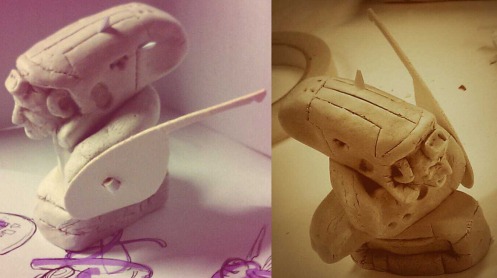3D Maquettes as part of the design process… Pt 2 – Clay Modelling.
Another way of visually developing 3D elements or concepts for your projects is via clay maquettes…
Remember, good design development practice can involve a number of methods for rigorous ideation. This traditional process is just another development/sketch tool available to you.
Concepts can be mocked up in clay quickly and without being too precious, much as you might use ink sketches or rapid photoshop concepts.
To save time, develop the maquettes at a workable but small scale at first (the character bust below was only around 80mm high), looking at form rather than becoming preoccupied with finish and detail.
By clay we usually mean dry-in-air products such as Super-sculpey, Fimo, and DAS clay. Specifically other products might be used in industry, but these are fast drying and representative of quick sculpt’ maquette materials; allowing concepts to be generated rapidly and without pressure to be fully finished.
This can also be taken through to basic 3D… Here’s a version based on the above in a rough and ready SketchUp file.
If nothing else, this flags up issues I might have with the initial shape (from the clay sculpt) when translating it into full digital 3D in a piece of software like 3DSMax, particularly keeping the headpiece as organic (not as blocky as the version above) as the intuitive clay version.
This next sculpt (done during a short session with students) included quick folded paper and card elements again, this time in a more substantial way.
Whilst this final one shows a way to avoid using more clay than you need to by simply creating something to mould the head around.
Anyway…
There is a wealth of sites and tutorials online to help you get started, including videos.
…
A quick scan of monster and SF/fantasy movie extras or “Making Of”s will show the use of these traditional sculpting skills in combination with more contemporary digital media.
See this great article over on IO9 – >HERE<
…
The physicality of the maquette and the ability to handle it and look at it from all angles easily and with focus control (courtesy of the human eye and hands) makes it an incredibly readily accessible concept medium.
This quick sculpt below, developed organically like a pencil sketch gave unpredicted results which keeps the character development process fresh.
It can also be quickly adapted by photographing and enhancing in Photoshop.
…
Check out this great video below from Gnomon…
…and this great site – Creature Spot
…
With all that in mind, the rough clay maquette can be just the start point for a piece of Concept work, you could always work it up in digital 2D once the basic shape is in place.
 Above – from pareidolia sketch, to clay-sculpted sketch…
Above – from pareidolia sketch, to clay-sculpted sketch…
…
Of course now the process can work in reverse, with quick 3D printing opportunities allowing scratch models to be built in 3D software and rapidly brought to the table top to be viewed and reviewed by design teams art directors and and other stakeholders in the creative process (producers, directors etc.)
3D printed maquettes based on In-Game Characters, design by Rikki Gregory.
…
See also, Sculpting in Card 001.








[…] it looks likely I’ll have to make a physical maquette in order to get the proportions to work fully. Watch this […]
The Exo-suit – Some new thoughts on the design… | Rabbit Heart said this on January 12, 2015 at 11:02 am |
[…] Two of those are dealt with below, whilst the Character model can be found back on the Clay Model Maquettes discussion page. […]
Paper & Card – 3D maquettes pt 3 | apophenia inc. said this on October 5, 2016 at 5:22 pm |